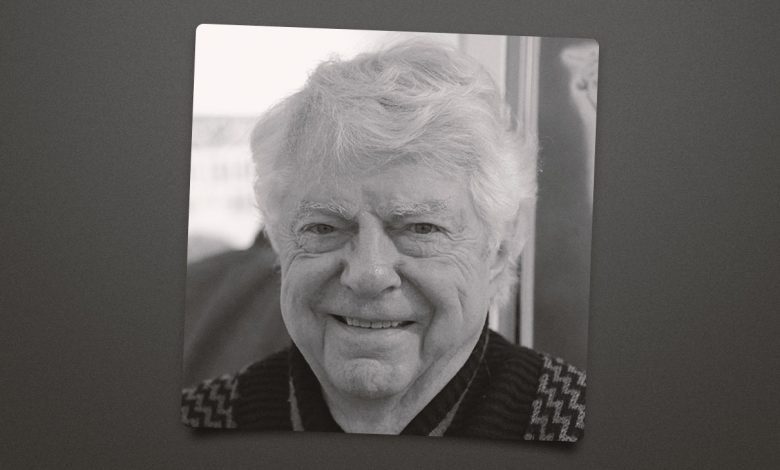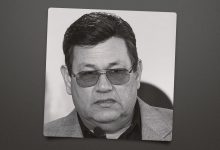Ralph Senensky, Director on ‘Star Trek’ and ‘The Waltons,’ Dies at 102

Ralph Senensky, the prolific TV director who called the shots for the emotional return of Ellen Corby on The Waltons, the three-part pilot for Dynasty and, before he was fired, 6 1/2 episodes of the original Star Trek, has died. He was 102.
Senensky died Saturday in a hospital in Carmel-by-the-Sea, California, his niece, costume designer Lisa Lupo-Silvas, told The Hollywood Reporter. “He was 100 precent sharp until the end,” she said. “He may have been 102, but he had a mind like he was 30.”
The Iowa native also helmed multiple episodes of Dr. Kildare, Naked City, 12 O’Clock High, The Fugitive, The F.B.I., Ironside, The Courtship of Eddie’s Father, Dan August, Nanny and the Professor, The Partridge Family, Barnaby Jones, Insight, Hart to Hart and The Paper Chase.
And in 1963 for the ABC medical drama Breaking Point, he handled one of the earliest gay storylines for television.
Among Star Trek fans, Senensky is synonymous with some of the best episodes of the Paramount/NBC series. Season one’s “This Side of Paradise” is regarded as one of the early standout Spock installments, and season’s two “Metamorphosis,” another installment that premiered in 1967, was his personal favorite.
For the third season, he embarked on 1968’s “The Tholian Web,” which saw Kirk (William Shatner), Spock (Leonard Nimoy), McCoy (DeForest Kelley) and Chekov (Walter Koenig) don shiny silver spacesuits as they investigate a crippled sister ship.
There was trouble ahead, however. Those zipper-less suits meant the actors had to be sewn into their costumes, then unsewn when they needed a bathroom break. By the third day of shooting, Senensky was four scenes behind schedule when he was called into producer Fred Freiberger’s office and fired.
On the pages of The Hollywood Reporter, Paramount executive Douglas S. Cramer announced that Herb Wallerstein would finish things up. Senensky got zero credit for his work.
“The article pointed out the studio’s intent to curtail the problem of films not being completed as scheduled,” Senensky reflected on his website. He said he received a phone call from Star Trek creator Gene Roddenberry, who was “outraged, apologetic and sympathetic.”
Over five years starting in 1973, Senensky directed 12 episodes of CBS’ The Waltons, perhaps none more moving than “Grandma Comes Home,” the sixth-season finale that aired on March 30, 1978.
The episode marked the return of Corby as Grandma Walton to the show after she had suffered a stroke in 1976. Writers incorporated her illness into the series, and she received top billing in the credits that week, with an Emmy nomination to soon follow.
In a 2011 chat for the Television Academy Foundation website The Interviews, Senensky noted that he spaced out Corby’s scenes across multiple days and only filmed in the morning to make it easier on her.
“They gave me two cameras at all times,” he said, “so when I was shooting her, I could shoot the over-the-shoulder and close-up all in one take.”
In the most powerful sequence, Grandma Walton — feeling as though she’s become a burden on the family — breaks down in tears opposite daughter-in-law Olivia (Michael Learned) as they snap beans on the porch.

Ellen Corby on The Waltons.
Courtesy of Everett Collection
When the dallies were shown in a screening room the following day, the director and those watching became emotional. From the back, Waltons creator Earl Hamner Jr. yelled, “Senensky, you son of a bitch!”
“It was the nicest words anybody ever called me,” he said.
The show’s iconic close of the family wishing “Good night” to one another was tweaked to have Corby say, “Good night, everyone” as the screen fades to black.
“How this performance came out of her in the condition she was in was truly a miracle,” Senensky said. “What she should have won was an award for a Profile in Courage.”
The older of two boys, Ralph Abbott Senensky was born in Mason City, Iowa, on May 1, 1923. His father, William, co-owned a clothing store, and his mother, Jenny, was a homemaker.
At Mason City High School, Senensky served as editor of the one-page weekly Cub Gazette and worked as a director’s assistant on school productions.
Shortly after the bombing of Pearl Harbor, he registered for the draft at age 18 and was stationed in Belgium. Upon his return, he did four years of community theater, studied at Northwestern and enrolled at the Pasadena Playhouse.
He eventually got his foot in the door at CBS in Los Angeles in 1955 typing radio scripts, became secretary for Playhouse 90 producer Russell Stoneham and was promoted to production supervisor. In that role, he visited Norman Felton daily, and the CBS executive producer recognized his name from a James Powers-written THR review of a play that Senensky had directed.
When Felton moved to MGM to launch Arena Productions, Senensky followed and made his TV directorial debut in 1961 on the first season of Richard Chamberlain‘s Dr. Kildare.
While working in November 1963 on the ABC crime series Arrest and Trial on Skid Row in Los Angeles, production was abruptly shut down when it was announced that President Kennedy had been assassinated.
“I remember sitting in the back seat of a car with bodies on either side of me,” Senensky recalled. “Mickey Rooney [a guest star] was in the front seat with bodies on either side of him, with the radio on, and all the inhabitants of Skid Row were around. It was like being in church as we heard the news report.”
Four months earlier, Senensky had helmed the Breaking Point episode “The Bull Roarer,” which starred Lou Antonio as a shy construction worker who questions his sexuality while dealing with his macho, dominating brother (Ralph Meeker).
The pivotal role on the Ben Casey spinoff was originally given to Dean Stockwell, but he had a change of heart after reading the script. Senensky then suggested Antonio, whom he had directed on ABC’s Naked City.
Breaking Point was produced by George Lefferts, whose contract stipulated he could choose a handful of topics usually ignored by the industry. The agreement came in handy when ABC censors objected to parts of the script.
“I think that was a historic moment in television,” Senensky wrote. “I am 99 and 44/100 percent sure that was the first time the word ‘homosexual’ was uttered in a drama in an American television show.”
Also in 1963, he directed Burgess Meredith in the hourlong Twilight Zone episode “Printer’s Devil” and two episodes of ABC’s Route 66.
In the ’70s, Senensky worked on telefilms including 1974’s Death Cruise, starring Richard Long and Polly Bergen; 1975’s The Family Nobody Wanted, starring Shirley Jones; and 1978’s The New Adventures of Heidi.
He directed just one feature, Harper Valley P.T.A. (1978), starring Barbara Eden, but he left two weeks before completion and was replaced by Richard Bennett.
Senensky then helmed the first three episodes of Aaron Spelling’s Dynasty that aired back-to-back-to-back on ABC on Jan. 12, 1981.
His final screen credit, after an absence of 27 years, was as director of the short film The Right Regrets (2013), written and produced by friend and actress Marlyn Mason.
“Ralph was a walking encyclopedia on film history,” Mason told obituarist Eve Golden. “Watching an old classic with him was equal to a semester at Harvard. … He chose to stay in the world of television, but when you look at his work, you feel you’re looking at a feature movie.”
In addition to his niece, survivors include his brother, Ervin; his sister-in-law, Audrey; and his great-nephew, Julien.
Despite directing nearly 200 TV episodes over 25 years, Senensky realized he primarily will be remembered for those 6 1/2 Star Trek shows. (He also helmed “Obsession,” “Return to Tomorrow,” “Bread and Circuses” and “Is There in Truth No Beauty?”)
Shortly after wrapping “This Side of Paradise” — he earned $3,000 for his first Star Trek gig, he said — he received a letter from Nimoy.
“It was not only a special Spock experience, but it was special for me as well in that I felt safely in the hands of a capable and sensitive director,” Nimoy wrote. “Unfortunately, a rare experience in TV.”
Mike Barnes contributed to this report.
HiCelebNews online magazine publishes interesting content every day in the TV section of the entertainment category. Follow us to read the latest news.





